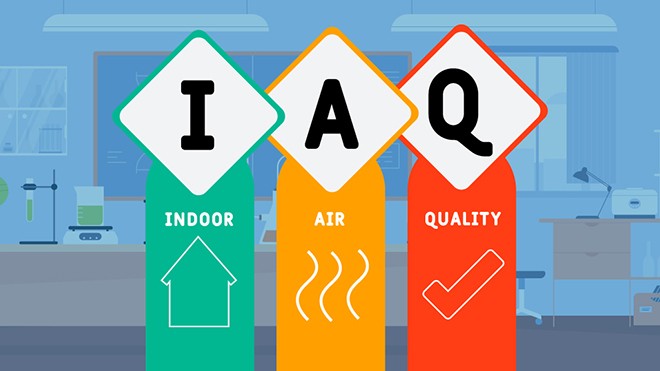
Understanding the Science Behind Indoor Air Quality
Indoor air quality (IAQ) is a critical aspect of our everyday lives, yet it’s often overlooked.
The air we breathe indoors can have a significant impact on our health and well-being. Understanding the science behind indoor air quality can help us better comprehend why it’s essential to maintain clean and healthy indoor environments.
What is Indoor Air Quality?
Indoor air quality refers to the quality of the air within and around buildings, especially as it relates to the health and comfort of occupants. Several factors can influence indoor air quality, including:
- Pollutants: Indoor air pollutants can include dust, pet dander, pollen, mold spores, volatile organic compounds (VOCs), and other harmful substances. These pollutants can come from a variety of sources, including outdoor air, building materials, cleaning products, and everyday activities such as cooking and smoking.
- Humidity: Humidity levels play a significant role in indoor air quality. High humidity levels can contribute to mold and mildew growth, while low humidity levels can lead to dry skin, irritated eyes, and respiratory problems.
- Ventilation: Proper ventilation is essential for maintaining good indoor air quality. Inadequate ventilation can lead to a buildup of indoor air pollutants, as well as increased levels of carbon dioxide and other harmful substances.
The Science Behind Indoor Air Quality
Several scientific principles govern indoor air quality, including:
- Particle Size: Indoor air pollutants come in a range of sizes, from large particles such as dust and pollen to smaller particles such as mold spores and bacteria. The size of these particles can affect how they are distributed throughout the indoor environment and how they impact our health. Smaller particles, known as respirable particles, can penetrate deep into the lungs and cause respiratory problems.
- Air Filtration: Air filtration systems are designed to remove airborne pollutants from the air. These systems use filters to trap particles as air passes through them, helping to improve indoor air quality and reduce the risk of respiratory problems. The effectiveness of an air filtration system depends on several factors, including the type of filter used, the size of the particles it can capture, and the airflow rate.
- Chemical Reactions: Indoor air pollutants can undergo chemical reactions with other substances present in the indoor environment, leading to the formation of new compounds that may be harmful to human health. For example, VOCs emitted from cleaning products, paints, and building materials can react with ozone to form harmful air pollutants known as secondary organic aerosols.
- Microbial Growth: High levels of humidity can promote microbial growth, including mold, bacteria, and viruses. These microorganisms can release harmful substances into the air, leading to respiratory problems and other health issues. Mold spores, in particular, can trigger allergies and asthma attacks in sensitive individuals.
Measuring Indoor Air Quality
Indoor air quality can be measured using a variety of instruments and techniques, including:
- Air Quality Monitors: Air quality monitors can measure the levels of various pollutants in the air, including particulate matter, VOCs, carbon dioxide, and other harmful substances. These monitors can provide real-time data on indoor air quality, allowing homeowners to take action to improve air quality as needed.
- Humidity Sensors: Humidity sensors can measure the relative humidity levels in the indoor environment, helping to identify areas where humidity levels may be too high or too low. Maintaining proper humidity levels is essential for preventing mold and mildew growth and reducing the risk of respiratory problems.
- Carbon Dioxide Monitors: Carbon dioxide monitors can measure the levels of carbon dioxide in the air, helping to identify areas where ventilation may be inadequate. High levels of carbon dioxide can indicate poor ventilation, which can lead to a buildup of indoor air pollutants and other harmful substances.
Improving Indoor Air Quality
There are several steps you can take to improve indoor air quality, including:
- Regular Cleaning: Regular cleaning can help remove dust, pet dander, and other pollutants from the indoor environment, reducing the risk of respiratory problems and other health issues. Be sure to vacuum carpets and upholstery regularly, dust surfaces with a damp cloth, and clean or replace air filters as needed.
- Proper Ventilation: Proper ventilation is essential for maintaining good indoor air quality. Be sure to open windows and doors when weather permits, and use exhaust fans in the kitchen and bathroom to remove pollutants from the air. Consider installing a whole-house ventilation system to ensure proper air exchange throughout the home.
- Air Filtration: Air filtration systems can help remove airborne pollutants from the air, improving indoor air quality and reducing the risk of respiratory problems. Choose a high-efficiency particulate air (HEPA) filter or an electrostatic precipitator for maximum effectiveness.
- Humidity Control: Maintaining proper humidity levels is essential for preventing mold and mildew growth. Use a dehumidifier to reduce humidity levels in areas where moisture is a problem, and use a humidifier to increase humidity levels in areas where the air is too dry. Aim for a relative humidity level of 30-50% for optimal comfort and health.
In conclusion, understanding the science behind indoor air quality is essential for creating clean and healthy indoor environments.

By taking steps to reduce indoor air pollutants, improve ventilation, and maintain proper humidity levels, you can create a safer, more comfortable living environment for you and your family.


